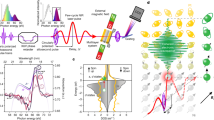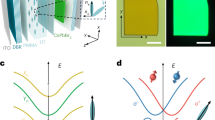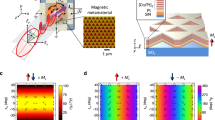Abstract
Coherent manipulation of spin ensembles is a key issue in the development of spintronics. In particular, multivalued spin switching may lead to new schemes of logic gating and memories. This phenomenon has been studied with atom vapours 30 years ago, but is still awaited in the solid state. Here, we demonstrate spin multistability with microcavity polaritons in a trap. Owing to the spinor nature of these light–matter quasiparticles and to the anisotropy of their interactions, we can optically control the spin state of a single confined level by tuning the excitation power, frequency and polarization. First, we realize high-efficiency power-dependent polarization switching. Then, at constant excitation power, we evidence polarization hysteresis and determine the conditions for realizing multivalued spin switching. Finally, we demonstrate an unexpected regime, where our system behaves as a high-contrast spin trigger. These results open new pathways to the development of advanced spintronics devices and to the realization of multivalued logic circuits.
This is a preview of subscription content, access via your institution
Access options
Subscribe to this journal
Receive 12 print issues and online access
$259.00 per year
only $21.58 per issue
Buy this article
- Purchase on Springer Link
- Instant access to full article PDF
Prices may be subject to local taxes which are calculated during checkout





Similar content being viewed by others
Change history
19 November 2010
In the version of this Article originally published, the x-axis of Figure 1c was incorrectly labelled 'meV' instead of 'μeV'. This error has now been corrected in the HTML and PDF versions.
References
Myers, R. C. et al. Zero-field optical manipulation of magnetic ions in semiconductors. Nature Mater. 7, 203–208 (2008).
Imamoğlu, A. Cavity QED based on collective magnetic dipole coupling: Spin ensembles as hybrid Two-Level systems. Phys. Rev. Lett. 102, 083602 (2009).
Greilich, A. et al. Ultrafast optical rotations of electron spins in quantum dots. Nature Phys. 5, 262–266 (2009).
Awschalom, D. D. & Flatte, M. E. Challenges for semiconductor spintronics. Nature Phys. 3, 153–159 (2007).
Lagoudakis, P. G. et al. Stimulated spin dynamics of polaritons in semiconductor microcavities. Phys. Rev. B 65, 161310 (2002).
Martín, M. D., Aichmayr, G., Viña, L. & André, R. Polarization control of the nonlinear emission of semiconductor microcavities. Phys. Rev. Lett. 89, 077402 (2002).
Kasprzak, J. et al. Bose-Einstein condensation of exciton polaritons. Nature 443, 409–414 (2006).
Bajoni, D. et al. Polariton laser using single micropillar GaAs-GaAlAs semiconductor cavities. Phys. Rev. Lett. 100, 047401 (2008).
Amo, A. et al. Collective fluid dynamics of a polariton condensate in a semiconductor microcavity. Nature 457, 291–295 (2009).
Leyder, C. et al. Observation of the optical spin Hall effect. Nature Phys. 3, 628–631 (2007).
Lagoudakis, K. G. et al. Observation of half-quantum vortices in an exciton-polariton condensate. Science 326, 974–976 (2009).
Baas, A., Karr, J. P., Eleuch, H. & Giacobino, E. Optical bistability in semiconductor microcavities. Phys. Rev. A 69, 023809 (2004).
Bajoni, D. et al. Optical bistability in a GaAs-based polariton diode. Phys. Rev. Lett. 101, 266402 (2008).
Tsintzos, S. I., Pelekanos, N. T., Konstantinidis, G., Hatzopoulos, Z. & Savvidis, P. G. A GaAs polariton light-emitting diode operating near room temperature. Nature 453, 372–375 (2008).
Deveaud-Pledran, B. Solid-state physics: Polaritronics in view. Nature 453, 297–298 (2008).
Shelykh, I. et al. Semiconductor microcavity as a spin-dependent optoelectronic device. Phys. Rev. B 70, 035320 (2004).
Kitano, M., Yabuzaki, T. & Ogawa, T. Optical tristability. Phys. Rev. Lett. 46, 926–929 (1981).
Cecchi, S., Giusfredi, G., Petriella, E. & Salieri, P. Observation of optical tristability in sodium vapors. Phys. Rev. Lett. 49, 1928–1931 (1982).
Dery, H., Dalal, P., Cywinski, L. & Sham, L. J. Spin-based logic in semiconductors for reconfigurable large-scale circuits. Nature 447, 573–576 (2007).
Behin-Aein, B., Datta, D., Salahuddin, S. & Datta, S. Proposal for an all-spin logic device with built-in memory. Nature Nanotech. 5, 266–270 (2010).
Gippius, N. A. et al. Polarization multistability of cavity polaritons. Phys. Rev. Lett. 98, 236401 (2007).
Shelykh, I. A., Liew, T. C. H. & Kavokin, A. V. Spin rings in semiconductor microcavities. Phys. Rev. Lett. 100, 116401 (2008).
Liew, T. C. H., Kavokin, A. V. & Shelykh, I. A. Optical circuits based on polariton neurons in semiconductor microcavities. Phys. Rev. Lett. 101, 016402 (2008).
Amo, A. et al. Exciton–polariton spin switches. Nature Photon. 4, 361–366 (2010).
El-Daïf, O. et al. Polariton quantum boxes in semiconductor microcavities. Appl. Phys. Lett. 88, 061105 (2006).
Kwong, N. H., Takayama, R., Rumyantsev, I., Kuwata-Gonokami, M. & Binder, R. Third-order exciton-correlation and nonlinear cavity-polariton effects in semiconductor microcavities. Phys. Rev. B 64, 045316 (2001).
Saba, M. et al. Crossover from exciton to biexciton polaritons in semiconductor microcavities. Phys. Rev. Lett. 85, 385 (2000).
Ramkumar, K. & Nagaraj, K. A ternary schmitt trigger. IEEE Trans. Circuits Systems 32, 732–735 (1985).
Christmann, G., Butté, R., Feltin, E., Carlin, J-F. & Grandjean, N. Room temperature polariton lasing in a GaN/AlGaN multiple quantum well microcavity. Appl. Phys. Lett. 93, 051102 (2008).
Jonsson, F. & Flytzanis, C. Polarization state controlled multistability of a nonlinear magneto-optic cavity. Phys. Rev. Lett. 82, 1426 (1999).
SoljaCiC, M. & Joannopoulos, J. D. Enhancement of nonlinear effects using photonic crystals. Nature Mater. 3, 211–219 (2004).
Zhou, L., Pu, H., Ling, H. Y. & Zhang, W. Cavity-mediated strong matter wave bistability in a spin-1 condensate. Phys. Rev. Lett. 103, 160403 (2009).
O’Brien, J. L., Furusawa, A. & Vuckovic, J. Photonic quantum technologies. Nature Photon. 3, 687–695 (2009).
Acknowledgements
The authors thank D. Sarchi, I. Carusotto, M. Portella-Oberli, T. C. H. Liew and V. Savona for fruitful discussions, and O. El Daïf for his contributions in engineering the sample. The present work was supported by the Swiss National Research Foundation through ‘NCCR Quantum Photonics’.
Author information
Authors and Affiliations
Contributions
T.K.P. carried out the experiments and data analysis. M.W. developed the theoretical model. M.W. and Y.L. did the simulations. F.M.G. made the sample. B.D.P. supervised the project.
Corresponding author
Ethics declarations
Competing interests
The authors declare no competing financial interests.
Supplementary information
Supplementary Information
Supplementary Information (PDF 527 kb)
Supplementary Information
Supplementary Information (MOV 431 kb)
Rights and permissions
About this article
Cite this article
Paraïso, T., Wouters, M., Léger, Y. et al. Multistability of a coherent spin ensemble in a semiconductor microcavity. Nature Mater 9, 655–660 (2010). https://doi.org/10.1038/nmat2787
Received:
Accepted:
Published:
Issue Date:
DOI: https://doi.org/10.1038/nmat2787
This article is cited by
-
Dispersion relation of the collective excitations in a resonantly driven polariton fluid
Nature Communications (2019)
-
Theory of the magnon Kerr effect in cavity magnonics
Science China Physics, Mechanics & Astronomy (2019)
-
Environmental engineering of transition metal dichalcogenide optoelectronics
Frontiers of Physics (2018)
-
Optical control of room-temperature valley polaritons
Nature Photonics (2017)
-
Prototype of a bistable polariton field-effect transistor switch
Scientific Reports (2017)



